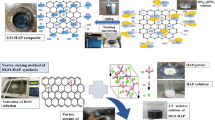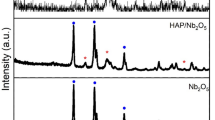Abstract
In the present study, a novel chitosan-functionalized graphene oxide decorated with glycidyl methacrylate (GO–CS–GMA) was synthesized and combined with nanohydroxyapatite particles (nHAp) to produce a novel hybrid synthetic natural material as a reinforcing phase for dental and biomedical purposes. In this process, the graphene oxide converted to GO–COCl, then reacted with chitosan (CS) to prepare GO–CS and final reaction of GO–CS with glycidyl methacrylate (GMA) gave methacrylate functionalized GO–CS–GMA. In another process, an alkyl bromide derivative of nanohydroxyapatite (nHAp-Br, radical initiator) was made from reaction of nHAP with 2-bromoisobutyryl bromide. Finally, atom transfer radical polymerization (ATRP) was used to the grafting of GO–CS–GMA onto nHAp surface to give nanohybrid compounds that were utilized in the nanocomposite formulation. The structure, thermal stability, and mechanical properties of the nanocomposites were investigated by FTIR, XRD, CHN, FE-SEM, and TGA. The thermal stability of the final composite was higher than its precursor nHAp and GO–CS–GMA. A synergistic effect of graphene oxide, chitosan, and glycidyl methacrylate on reinforcing hydroxyapatite has been observed. The resulting nanocomposite revealed around 56% and 20% increases in compressive and flexural strength, respectively, in comparison with hydroxyapatite. In addition, both compressive and flexural strengths of new composites were improved in comparison with the conventional composites which are made from barium glass fillers. Cellular studies using human alveolar basal epithelial cells (A549 cell line) suggest that remarkable biocompatibility is shown by nHAp-g-GO–CS–GMA, which makes it an encouraging material for biomedical applications.
Graphical abstract













Similar content being viewed by others
References
Chong HM, Hinder SJ, Taylor AC (2016) Graphene nanoplatelet-modified epoxy: effect of aspect ratio and surface functionality on mechanical properties and toughening mechanisms. J Mater Sci 51:8764–8790
Wu LG, Yang CH, Wang T, Zhang XY (2018) Enhanced the performance of graphene oxide/polyimide hybrid membrane for CO2 separation by surface modification of graphene oxide using polyethylene glycol. Appl Surf Sci 440:1063–1072
Zhao D, Gao X, Wu C, Xie R, Feng S, Chen C (2016) Facile preparation of amino functionalized graphene oxide decorated with Fe3O4 nanoparticles for the adsorption of Cr (VI). Appl Surf Sci 384:1–9
Li H, Shi LY, Cui W, Lei WW, Zhang YL, Diao YF, Ran R, Ni W (2015) Covalent modification of graphene as a 2D nanofiller for enhanced mechanical performance of poly (glutamate) hybrid gels. RSC Adv 5:86407–86413
Othmani M, Aissa A, Bac CG, Rachdi F, Debbabi M (2013) Surface modification of calcium hydroxyapatite by grafting of etidronic acid. Appl Surf Sci 274:151–157
Liu, Y (2014) Application of surface functionalization for designing novel interfaces and materials .Doctoral dissertation, University of Delaware.
Shin HK, Rhee KY, Park SJ (2016) Effects of exfoliated graphite on the thermal properties of erythritol-based composites used as phase-change materials. Compos B Eng 96:350–353
Haleem YA, Liu D, Chen W, Wang C, Hong C, He Z, Liu J, Song P, Yu S, Song L (2015) Surface functionalization and structure characterizations of nanodiamond and its epoxy based nanocomposites. Compos B Eng 78:480–487
Beyler-Çiğil A, Kahraman MV (2016) Effect of surface modification on nano-diamond particles for surface and thermal property of UV-curable hybrid coating. Progress in organic coatings. Prog Org Coat 101:468–476
Georgiopoulos P, Christopoulos A, Koutsoumpis S, Kontou E (2016) The effect of surface treatment on the performance of flax/biodegradable composites. Compos B Eng 106:88–98
Bhattacharya M (2016) polymer nanocomposites—a comparison between carbon nanotubes, graphene, and clay as nanofillers. Materials 9:262–297
Sun X, Liu Z, Welsher K, Robinson JT, Goodwin A, Zaric S, Dai H (2008) Nano-graphene oxide for cellular imaging and drug delivery. Nano Res 1:203–212
Li M, Wang Y, Liu Q, Li Q, Cheng Y, Zheng Y, Xi T, Wei S (2013) In situ synthesis and biocompatibility of nano hydroxyapatite on pristine and chitosan functionalized graphene oxide. J Mater Chem B 4:475–484
Wang X, Bai H, Yao Z, Liu A, Shi G (2010) Electrically conductive and mechanically strong biomimetic chitosan/reduced graphene oxide composite films. J Mater Chem 41:9032–9036
Yang X, Tu Y, Li L, Shang S, Tao XM (2010) Well-dispersed chitosan/graphene oxide nanocomposites. ACS Appl Mater Interfaces 2:1707–1713
Fan H, Wang L, Zhao K, Li N, Shi Z, Ge Z, Jin Z (2010) Fabrication, mechanical properties, and biocompatibility of graphene-reinforced chitosan composites. Biomacromol 11:2345–2351
Pan Y, Wu T, Bao H, Li L (2011) Green fabrication of chitosan films reinforced with parallel aligned graphene oxide. Carbohydrate polymers Carbohydrate polymers 83:1908–1915
Loutfy SA, El-Din HM, Elberry MH, Allam NG, Hasanin MT, Abdellah AM (2016) Synthesis, characterization and cytotoxic evaluation of chitosan nanoparticles: in vitro liver cancer model. Adv Nat Sci Nanosci Nanotechnol 7: 035008.
Depan D, Girase B, Shah JS, Misra RD (2011) Structure–process–property relationship of the polar graphene oxide-mediated cellular response and stimulated growth of osteoblasts on hybrid chitosan network structure nanocomposite scaffolds. Acta Biomater 7:3432–3445
Elizalde-Peña EA, Flores-Ramirez N, Luna-Barcenas G, Vásquez-García SR, Arámbula-Villa G, García-Gaitán B, Rutiaga-Quinones JG, González-Hernández J (2007) Synthesis and characterization of chitosan-g-glycidyl methacrylate with methyl methacrylate. Eur Polymer J 43:3963–3969
Coelho CC, Grenho L, Gomes PS, Quadros PA, Fernandes M (2019) Nanohydroxyapatite in oral care cosmetics: Characterization and cytotoxicity assessment. Sci Rep 9:1–10
Szcześ A, Hołysz L, Chibowski E (2017) Synthesis of hydroxyapatite for biomedical applications. Adv Coll Interface Sci 249:321–330
Sanosh KP, Chu MC, Balakrishnan A, Lee YJ, Kim TN, Cho SJ (2009) Synthesis of nano hydroxyapatite powder that simulate teeth particle morphology and composition. Curr Appl Phys 9:1459–1462
Hu H, Huang BW, Lee YT, Hu J, Wong SW, Ko CC, You W (2018) Dramatic improvement of the mechanical strength of silane-modified hydroxyapatite–gelatin composites via processing with cosolvent ACS omega. 3: 3592-3598
Rashidi AR, Wahit MU, Abdullah MR, Abdul Kadir MR (2015) The effect of silane on the biomechanical properties of PEEK/HA composite. Adv Mater Res 1125:426–431
Liu Q, Bakker D, Van Toledo M, Van Blitterswijk CA (1998) Polyacids as bonding agents in hydroxyapatite polyester-ether (PolyactiveTM 30/70) composites. J Mater Sci-Mater M 9:23–30
Misra DN (1985) Adsorption of zirconyl salts and their acids on hydroxyapatite: use of the salts as coupling agents to dental polymer composites. J Dent Res 64:1405–1408
Liu Q, de Wijn JR, Van Blitterswijk CA (1998) Covalent bonding of PMMA, PBMA, and poly (HEMA) to hydroxyapatite particles. J Biomed Mat Res Offi J Soc Biomat J Biomed Mater Res 40:257–263
Matyjaszewski K, Xia J (2001) Atom transfer radical polymerization. Chem Rev Chem Rev 101:2921–2990
Jiang H, Wang XB, Li CY, Li JS, Xu FJ, Mao C, Yang WT, Shen J (2011) Improvement of hemocompatibility of polycaprolactone film surfaces with zwitterionic polymer brushes.Langmuir 27: 11575–11581.
Xu FJ, Wang ZH, Yang WT(2010) Surface functionalization of polycaprolactone films via surface-initiated atom transfer radical polymerization for covalently coupling cell-adhesive biomolecules. Biomaterial 31 :3139–3147.
He J, Yang X, Mao J, Xu F, Cai Q (2012) Hydroxyapatite–poly (l-lactide) nanohybrids via surface-initiated ATRP for improving bone-like apatite-formation abilities. Appl Surf Sci 258:6823–6830
Xiao Y, Lang S, Wang Y, Lang M (2014) Effect of surface grafted hydroxyapatite on the improved performance of hydroxyapatite/poly (ε-caprolactone) scaffold. Current Nanosci Current Nanosci 10:855–862
Wang Y, Zhang X, Yan J, Xiao Y, Lang M (2011) Surface modification of hydroxyapatite with poly (methyl methacrylate) via surface-initiated ATRP. Appl Surf Sci 257:6233–6238
Zhang S, Yang Q, Zhao W, Qiao B, Cui H, Fan J, Li H, Tu X, Jiang D (2016) In vitro and in vivo biocompatibility and osteogenesis of graphene-reinforced nanohydroxyapatite polyamide66 ternary biocomposite as orthopedic implant material. Int J Nanomed 11:3179–3189
Zhang H, Zhang M (2010) Effect of surface treatment of hydroxyapatite whiskers on the mechanical properties of bis-GMA-based composites. Biomed Mat 5: 054106.
Mohammadnia MS, Hemmati S, Ghasemi N, Bahari M (2019) Preparation of carboxylated graphene oxide/polydimethacrylate nanocomposites via atom transfer radical polymerization and the mechanical properties of nanocomposites. Polym Sci, Ser B 61:349–360
ISO 4049: 2000. Polymer-based filling, restorative and luting materials Geneva, Switzerland: International Organization for Standardization
Mohandes F, Salavati-Niasari MJ (2014) Freeze-drying synthesis, characterization and in vitro bioactivity of chitosan/graphene oxide/hydroxyapatite nanocomposite. RSC Adv 4:25993–26001
Zuo PP, Feng HF, Xu ZZ, Zhang LF, Zhang YL, Xia W, Zhang WQ (2013) Fabrication of biocompatible and mechanically reinforced graphene oxide-chitosan nanocomposite films. Chem Cent J 7:39–50
Zeng L, Wang H, Fu G, Jiang J, Zhang X (2010) A new approach for synthesis of the comb-shaped poly (ε-caprolactone) brushes on the surface of nanohydroxyapatite by combination of ATRP and ROP.J. Colloid Interf Sci 352:36–42
Htut KZ, Kim M, Lee E, Lee G, Baeck SH, Shim SE (2017) Biodegradable polymer-modified graphene/polyaniline electrodes for supercapacitors. Synth Met 227:61–70
Agarwal K, Kuchipudi SK, Girard B, Houser M (2018) Mechanical properties of fiber reinforced polymer composites: A comparative study of conventional and additive manufacturing methods. J Compos Mater 52:3173–3181
Ferracane JL (2011) Resin composite—state of the art. Dent Mater 27:29–38
Chung SM, Yap AUJ, Chandra SP, Lim CT (2004) Flexural strength of dental composite restoratives: Comparison of biaxial and three-point bending test. J Biomed Mat Res Part B Appl Biomat Off J Soc Biomater Jap Soc Biomat Aus Soc Biomat Kor Soc Biomat 71:278–283
Epple M (2018) Review of potential health risks associated with nanoscopic calcium phosphate. Acta Biomater 77:1–14
Kavinkumar T, Varunkumar K, Ravikumar V, Manivannan S (2017) Anticancer activity of graphene oxide-reduced graphene oxide-silver nanoparticle composites. J Coll Int Sci 505:1125–1133
Saleth LR, Ravichandhren S, SeethalakshmiIllanchezian SR, Illanchezian S (2014) Antiproliferative effect of Prawn Shells Chitosan on Lung cancer (A549) cell line. Int J ChemTech Res 6:4102–4107
Funding
This work is funded by research and technology of Tabriz University of Medical Science (Grant No. 62711) and Iran Nanotechnology Initiative Council (INIC).
Author information
Authors and Affiliations
Contributions
SH contributed to project administration, formal analysis, and writing and editing. MSM contributed to investigation, experimental, software, and writing and review. MFR and MB collaborate in analysis.
Corresponding author
Ethics declarations
Conflict of interest
The authors declare that they have no conflict of interest.
Additional information
Publisher's Note
Springer Nature remains neutral with regard to jurisdictional claims in published maps and institutional affiliations.
Rights and permissions
About this article
Cite this article
Mohammadnia, M.S., Hemmati, S., Fasihi-Ramandi, M. et al. Synthesis of novel surface-modified nanohydroxyapatite containing chitosan-functionalized graphene oxide decorated with glycidyl methacrylate (GO–CS–GMA) via ATRP for biomedical application. Polym. Bull. 79, 9833–9858 (2022). https://doi.org/10.1007/s00289-021-03968-4
Received:
Revised:
Accepted:
Published:
Issue Date:
DOI: https://doi.org/10.1007/s00289-021-03968-4




